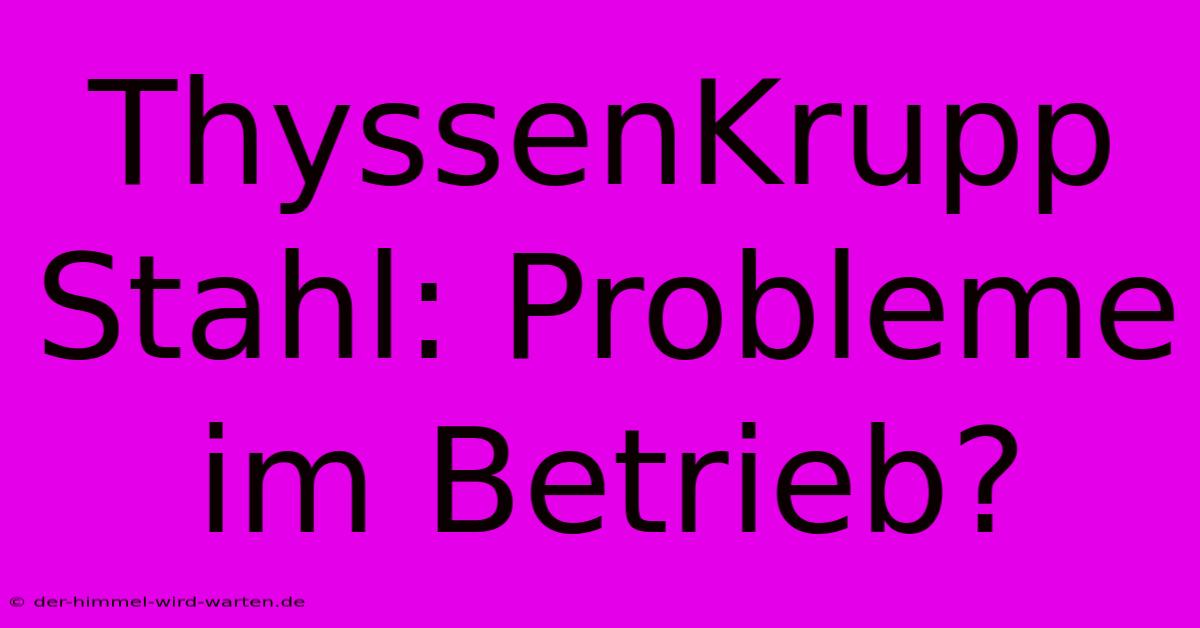ThyssenKrupp Stahl: Probleme Im Betrieb?

Discover more detailed and exciting information on our website. Click the link below to start your adventure: Visit Best Website ThyssenKrupp Stahl: Probleme Im Betrieb?. Don't miss out!
Table of Contents
ThyssenKrupp Stahl: Probleme im Betrieb? Ein Insider-Blick
Hey Leute, let's talk about ThyssenKrupp Stahl – specifically, the problems they've been facing. I've been following this industry for years, and honestly, it's been a rollercoaster. My uncle worked there for decades, so I've heard a lot of inside stories, both good and bad. This isn't some academic analysis; this is from the trenches, okay?
Die Herausforderungen von ThyssenKrupp Stahl
ThyssenKrupp Stahl, right? A giant in the industry, but giants have their struggles, you know? One of the biggest issues I've seen discussed, and that my uncle mentioned countless times, is competition. The global steel market is brutal. There's cheap imports from countries with, let's say, less stringent labor laws and environmental regulations. This undercuts domestic producers like ThyssenKrupp, making it hard to compete on price. It’s a real problem.
Kostendruck und Effizienzsteigerung
Another huge thing is cost pressure. Raw materials like iron ore and coal fluctuate wildly in price. Energy costs are also through the roof. To stay afloat, ThyssenKrupp needs to constantly improve its efficiency. This means investing in new technologies, automating processes, and unfortunately, sometimes, reducing its workforce. It's a tough balancing act, and honestly, sometimes I think they've stumbled.
Die Rolle der Digitalisierung
The digital transformation – or lack thereof – is another big topic. Many older steel plants, like some of ThyssenKrupp's, are still pretty reliant on older technologies. Updating these systems is expensive! But it's also crucial for improving efficiency, monitoring production processes, and reducing waste. My uncle always complained about the outdated equipment. It slowed things down immensely and made things less efficient. This also affects their ability to compete effectively in the modern market place. They need to catch up!
Umweltvorschriften und Nachhaltigkeit
Then there's the whole sustainability thing. Steel production is notoriously energy-intensive and produces significant greenhouse gas emissions. There's increasing pressure from governments and consumers for companies to reduce their carbon footprint. ThyssenKrupp has to invest heavily in greener technologies and processes to meet these requirements. That means more capital expenditure.
So, was kommt als nächstes?
Predicting the future of ThyssenKrupp Stahl is tricky. They've got some serious challenges to overcome. But they also have a strong brand, skilled workforce (at least they used to), and some cutting-edge technologies in their portfolio. They need to focus on streamlining operations, embracing digitalization, and investing wisely in sustainable solutions.
I am not an expert in financial forecasting, but I believe that if ThyssenKrupp adapts quickly and strategically, they can overcome these issues. They need a really good plan to tackle competition, implement sustainable practices, and leverage technology to their advantage. Otherwise, the future might be… grim.
Persönliche Schlussfolgerung:
Honestly, watching ThyssenKrupp struggle has been...well, depressing. My uncle's stories weren't always happy ones, but they gave me a real understanding of the industry's complexities. I hope they can navigate these challenges and come out stronger. But it's going to take a lot of work. This isn't going to be a quick fix; it's a marathon, not a sprint. The steel industry is tough, guys. Really tough.
This article is for informational purposes only and does not constitute financial or investment advice. Always do your own research.

Thank you for visiting our website wich cover about ThyssenKrupp Stahl: Probleme Im Betrieb?. We hope the information provided has been useful to you. Feel free to contact us if you have any questions or need further assistance. See you next time and dont miss to bookmark.
Featured Posts
-
Nestroy Preise 2023 Edtmeier Und Stolzmann
Nov 26, 2024
-
Merkur Bank Aktie Sorgen Berechtigt
Nov 26, 2024
-
Orange The World Gewalt Stoppen
Nov 26, 2024
-
Mal Payes So Klappts Schnell
Nov 26, 2024
-
Work Life Balance Die Besten Laender 2024
Nov 26, 2024
